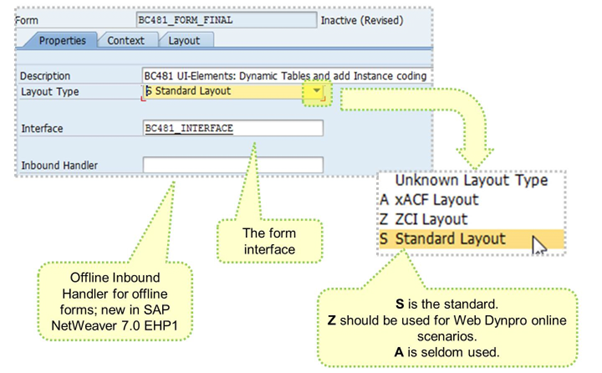The Form Context
The Form Context
The layout type is the most important property of the form template.

You use the layout type to define the runtime environment in which the form template is to be used.Layout Types
The layout type is relevant if you create forms with scripting for interactive scenarios.
You can choose between the Active Component Framework (ACF), which requires additional software installation (see SAP Note 766191) on the user's PC, and the newer version, Zero Client Installation (ZCI), which requires no extra installation, only a current version of Adobe Reader.
- Standard layout: Layout type for form templates for output forms (for printing, archiving, and e-mail) and interactive offline forms (for sending by e-mail).
- xACF layout: Layout type for form templates that are integrated into Web Dynpro applications at runtime using the Active Component Framework. ActiveX must be activated in the browser. You can only make this setting if the layout type of your form template is unknown. If the layout type is already set to Standard Layout or ZCI Layout, you cannot select this layout type. However, you can still access your old form template by using the version management function.
- ZCI layout: Layout type for form templates that are integrated into Web Dynpro applications at runtime using Zero Client Installation. You only have to set the layout type for new form templates. If you migrated old form templates to ZCI, the system enters this value automatically.
Inbound Handler
The inbound handler is new as of SAP NetWeaver 7.0 with EHP 1.
It is a piece of object-oriented coding to supply the parsing and extraction process of offline forms.

The context area of forms contains those elements that will be available in the form layout. These fields are a subset of the interface, and include additional elements like graphics or texts. You can create new elements by right-clicking on the context.
The form interface is displayed on the left of the screen for defining the context of a form template. If you need to integrate elements of a form interface into the layout, you can take different elements – such as data fields, structures, and tables – from the form interface and include them in the context.
To include an element from the form interface in the context, you can use the mouse to drag it to the required location. You can also use the Create menu in the context structure, which you can call for any structure node.
The system sends the form context to the layout function of Form Builder automatically. If you design the form layout using Adobe LiveCycle Designer, for example, the data fields of the form context are available for integration into the form layout.
Context hierarchy: You create the data fields of the form context in a hierarchical structure. The top structure node has the name of the form template. The form context structure can contain the following types of data fields: data fields from the form interface, data fields for texts, addresses and graphics, and folders.
Logic in the context: You define the form logic for each structure node of the form context. You can, for example, define conditions or alternative nodes for a node. When the form is generated, the system only takes the nodes and subnodes of the form context into account if the conditions are met. For tables, you can also specify WHERE conditions for data selection. In this way, you can hide any items, such as table fields, that you do not need.

Double-clicking on an element from the context will display its details in the bottom-right area.
For example, you would set the source for an image or the name of an external text here.
As of SAP NetWeaver 6.40, for fields with Dictionary reference, their texts can automatically be integrated into the form layout to be used as captions. As the Dictionary (or, more precisely, the data element) offers four different kinds of texts, you can choose which one to use.
A condition in the context can be compared with the ABAP statement IF-ENDIF. It is a kind of “ABAP light” coding.